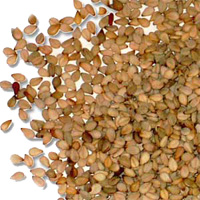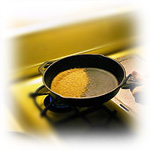Cooking with Sesame
 Perhaps the oldest condiment on earth,
sesame seeds have been processed into various forms since 1600 B.C. This
familiar topping for hamburger buns is also pressed to make sesame oil and
crushed to make sesame paste. Asian sesame paste and sesame oil are made
from toasted sesame seeds, while Middle Eastern sesame paste (tahini) and
cold-pressed sesame oil are made from un-toasted sesame seeds. Perhaps the oldest condiment on earth,
sesame seeds have been processed into various forms since 1600 B.C. This
familiar topping for hamburger buns is also pressed to make sesame oil and
crushed to make sesame paste. Asian sesame paste and sesame oil are made
from toasted sesame seeds, while Middle Eastern sesame paste (tahini) and
cold-pressed sesame oil are made from un-toasted sesame seeds.
When choosing sesame seeds: For the
best price, buy sesame seeds in bulk rather than in tiny jars. While
ivory-colored seeds are the most common, you can also buy black, brown, or
red sesame seeds. When buying sesame oil for cooking, be sure to look for
"pure" toasted sesame oil. It should be dark amber in color. Some
of the
supermarkets carry toasted sesame oil that is mixed with less-expensive
oils such as canola oil, which dilutes the toasted sesame flavor. Japanese
brands of pure toasted sesame oil are consistently delicious.
To store sesame seeds: Keep sesame
seeds in a tightly sealed jar in the refrigerator up to 6 months.
Likewise, keep all forms of sesame oil in the refrigerator, as sesame oil
tends to become rancid easily. Don't worry if the oil becomes cloudy from
the cold temperatures; it will clear up again upon reaching room
temperature. Tahini can be refrigerated for up to 1 year after opening.

Toasting sesame seeds: Place them in
a dry skillet and toast over low heat, shaking the pan often, until the
seeds are fragrant and golden brown, about 2 minutes. Transfer to a plate
so that the seeds do not continue cooking in the hot pan, which could make
them dark and bitter-tasting.
Using toasted sesame seeds: Toss them
freely over steamed broccoli, green beans, asparagus, grilled chicken,
green salads, stir-fries, rice, and most any other dish. If using sesame
seeds to top baked goods, add them raw rather than toasted. The seeds will
toast in the oven.
Using toasted sesame oil: For the
most flavor, add it at the end of the cooking time. If heated too long,
toasted sesame oil loses much of its nutty flavor. Also, avoid using too
much toasted sesame oil, which can cause a cloying sensation at the back
of the tongue. For a stir-fry that serves 4, about 1/2 teaspoon is plenty.
Fascinating Fact: Toasted sesame
seeds are so appreciated in Japan that the Japanese invented a special
little skillet with a screened lid for toasting them. Sesame seeds
sometimes pop out of the pan during toasting, so the screened top is
handy. An inverted large-mesh sieve will also do the trick. Avoid using a
solid pan lid, which would trap steam in the pan and turn the seeds soggy.
<Go Top>
Happy Cooking,
Carol |

